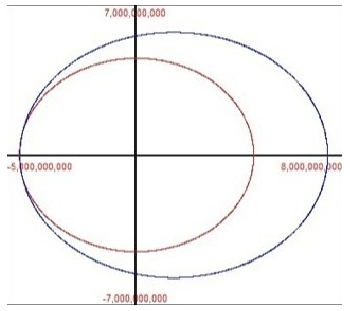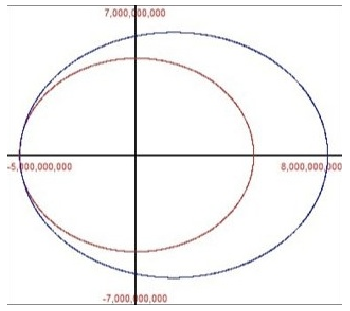
(a)
To find: the polar equation of the orbit of a planet
(a)
Answer to Problem 63E
The polar equation of the orbit of a planet Neptune is
The planet Pluto is
Explanation of Solution
Given:
Calculation:
For Neptune: Use the equation given values.
For Pluto: Use the equation given values.
Conclusion:
Therefore, the polar equation of the orbit of a planet Neptune is
(b)
To find: the perihelion and aphelion distances for each planet.
(b)
Answer to Problem 63E
The perihelion and aphelion distances of Neptune planet is
Explanation of Solution
Calculation:
For Neptune: Use the formula from exercise 49 to find the perihelion.
For Pluto: Use the formula from exercise 49 to find the perihelion.
Conclusion:
Therefore, the perihelion and aphelion distances of Neptune planet is
(c)
To graph: Neptune’s and Pluto’s equations of orbit
(c)
Answer to Problem 63E

Explanation of Solution
Calculation:
Graph the equations for the orbits of both planets.
Red: Neptune
Blue: Pluto

Conclusion:
Therefore, the equation is drawn.
(d)
To prove: the Pluto called the ninth planet and Neptune the eighth planet.
(d)
Answer to Problem 63E
On average, Pluto is farther from the sun than Neptune is.
Explanation of Solution
Pluto's perihelion is less than Neptune's perihelion and aphelion, so there is a point at which Pluto is closer to the sun than Neptune is. On average, Pluto is farther from the sun than Neptune is.
Conclusion:
Therefore, On average, Pluto is farther from the sun than Neptune is.
(e)
To explain: whether the orbits of Neptune and Pluto intersect and collide.
(e)
Answer to Problem 63E
Pluto and Neptune will not collide.
Explanation of Solution
Pluto and Neptune will not collide. Even though the graph in part c shows that their orbits intersect, it does not show what happens in three-dimensional space.
Conclusion:
Therefore, Pluto and Neptune will not collide.
Chapter 9 Solutions
PRECALCULUS W/LIMITS:GRAPH.APPROACH(HS)
- Find the accumulated amount A, if the principal P is invested at an interest rate of r per year for t years. (Round your answer to the nearest cent.) P = $3800, r = 4%, t = 10, compounded semiannually A = $ 5645.60 × Need Help? Read It SUBMIT ANSWER [3.33/6.66 Points] DETAILS MY NOTES REVIOUS ANSWERS ASK YOUR TEACHER TANAPCALC10 5.3.001.EP. PRACTICE ANOTHER Consider the following where the principal P is invested at an interest rate of r per year for t years. P = $3,100, r = 4%, t = 10, compounded semiannually Determine m, the number of conversion periods per year. 2 Find the accumulated amount A (in dollars). (Round your answer to the nearest cent.) A = $ 4604.44arrow_forwardForce with 800 N and 400 N are acting on a machine part at 30° and 60°, respectively with a positive x axis, Draw the diagram representing this situationarrow_forwardI forgot to mention to you to solve question 1 and 2. Can you solve it using all data that given in the pict i given and can you teach me about that.arrow_forward
 Calculus: Early TranscendentalsCalculusISBN:9781285741550Author:James StewartPublisher:Cengage Learning
Calculus: Early TranscendentalsCalculusISBN:9781285741550Author:James StewartPublisher:Cengage Learning Thomas' Calculus (14th Edition)CalculusISBN:9780134438986Author:Joel R. Hass, Christopher E. Heil, Maurice D. WeirPublisher:PEARSON
Thomas' Calculus (14th Edition)CalculusISBN:9780134438986Author:Joel R. Hass, Christopher E. Heil, Maurice D. WeirPublisher:PEARSON Calculus: Early Transcendentals (3rd Edition)CalculusISBN:9780134763644Author:William L. Briggs, Lyle Cochran, Bernard Gillett, Eric SchulzPublisher:PEARSON
Calculus: Early Transcendentals (3rd Edition)CalculusISBN:9780134763644Author:William L. Briggs, Lyle Cochran, Bernard Gillett, Eric SchulzPublisher:PEARSON Calculus: Early TranscendentalsCalculusISBN:9781319050740Author:Jon Rogawski, Colin Adams, Robert FranzosaPublisher:W. H. Freeman
Calculus: Early TranscendentalsCalculusISBN:9781319050740Author:Jon Rogawski, Colin Adams, Robert FranzosaPublisher:W. H. Freeman
 Calculus: Early Transcendental FunctionsCalculusISBN:9781337552516Author:Ron Larson, Bruce H. EdwardsPublisher:Cengage Learning
Calculus: Early Transcendental FunctionsCalculusISBN:9781337552516Author:Ron Larson, Bruce H. EdwardsPublisher:Cengage Learning





